
Datura wrightii, commonly known as sacred datura, is a poisonous perennial plant species and ornamental flower of the family Solanaceae native to the Southwestern United States and northwestern Mexico. It is sometimes used as a hallucinogen due to its psychoactive alkaloids. D. wrightii is classified as an anticholinergic deliriant.

Lithospermum is a genus of plants belonging to the family Boraginaceae. The genus is distributed nearly worldwide, but most are native to the Americas and the center of diversity is in the southwestern United States and Mexico. Species are known generally as gromwells or stoneseeds.

Lithospermum officinale, or common gromwell or European stoneseed, is a flowering plant species in the family Boraginaceae, native to Eurasia. It is the host plant for caterpillars of the monophagous moth Ethmia dodecea.

Eriogonum fasciculatum is a species of wild buckwheat known by the common names California buckwheat and flat-topped buckwheat. Characterized by small, white and pink flower clusters that give off a cottony effect, this species grows variably from a patchy mat to a wide shrub, with the flowers turning a rusty color after blooming. This plant is of great benefit across its various habitats, providing an important food resource for a diversity of insect and mammal species. It also provides numerous ecosystem services for humans, including erosion control, post-fire mitigation, increases in crop yields when planted in hedgerows, and high habitat restoration value.
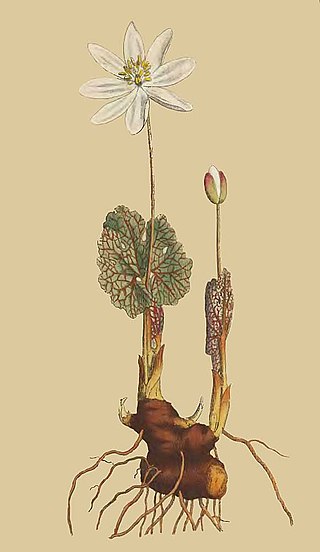
Puccoon is a common name that refers to any of several plants formerly used by certain Native Americans for dyes. The dyes were made from the plants' roots.

Lithospermum canescens, or the hoary puccoon is a perennial herb endemic to eastern North America. The plant grows in a variety of habitats. It has golden yellow flowers which bloom from April to May.

Lithospermum caroliniense, commonly known as the hairy puccoon or Carolina puccoon or Plains puccoon, is a flowering plant found in the Midwestern United States and Canadian provinces surrounding the Great Lakes. The plant grows in sandhills, pine barrens, and dry, sandy woods.

Hymenopappus filifolius is a North American species of flowering plant in the daisy family known by the common names fineleaf hymenopappus and Columbia cutleaf. It is native to western and central North America from Alberta and Saskatchewan south as far as Chihuahua and Baja California.

Krascheninnikovia lanata is a species of flowering plant in the family Amaranthaceae, known by the common name winterfat. It is native to much of western North America: from central Western Canada; through the Western United States; to northern Mexico.
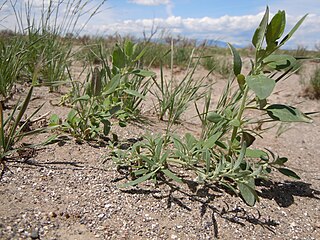
Chenopodium leptophyllum is a species of flowering plant in the family Amaranthaceae known by the common name narrowleaf goosefoot.
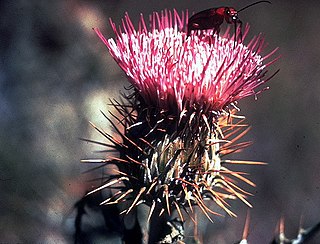
Cirsium ochrocentrum is a species of thistle known by the common name yellowspine thistle. It is native to the Great Plains of the Central United States and to the desert regions of the western United States and northern Mexico. Its range extends from eastern Oregon east to the Black Hills of South Dakota, south as far as the Mexican State of Durango.
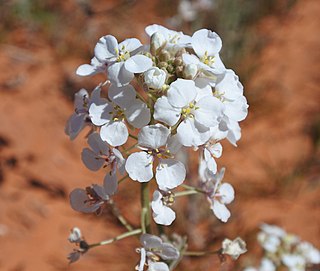
Dimorphocarpa wislizeni, commonly known as spectacle pod, Wislizeni's spectaclepod, and touristplant, is a flowering plant in the mustard family native to western North America, where it occurs in the southwestern United States as far east as Oklahoma and Texas, and Baja California, Sonora, Chihuahua, and Coahuila in Mexico.

Lithospermum californicum is a species of flowering plant in the borage family known by the common name California stoneseed. It is native to southern Oregon and northern California, where it can be found in many types of mountain habitat, such as forest, woodland, and chaparral, sometimes on serpentine soils.
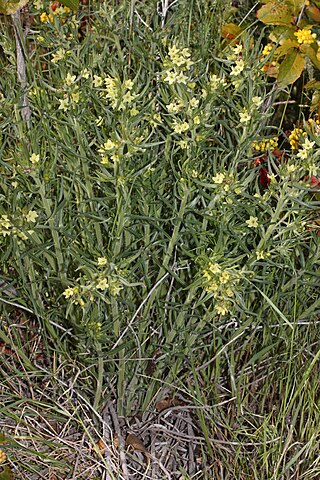
Lithospermum ruderale is a species of flowering plant in the borage family known by the common name western stoneseed or lemonweed. It is native to western Canada and the western United States, where it can be found in many types of habitat. A perennial herb growing from a taproot and woody caudex, it is covered with fine, more or less upright, hairs, especially on the stems. It produces a cluster of erect leafy stems ranging from 20 to 50 centimetres centimeters in height. The stems support lance-shaped leaves ranging from 2.5–10 cm (1–4 in) in length. Bunches of flowers with leaf-like bracts appear toward the top of the stem amongst the leaves. The corolla is fused at the base with five lobes which are light yellow, often slightly greenish, and about a centimeter long and wide. The style is short. The fruit consists of one or two, sometimes four, clustered glossy grey nutlets, 3.5 to 6, sometimes as much as 8 mm long.

Mirabilis multiflora is a species of flowering plant in the four o'clock family known by the common name Colorado four o'clock that is native to the southwestern United States from California to Colorado and Texas, as well as far northern Mexico, where it grows in mostly dry habitat types in a number of regions.

Orobanche fasciculata is a species of broomrape known by the common name clustered broomrape. It is native to much of western and central North America from Alaska to northern Mexico to the Great Lakes region, where it grows in many types of habitat. It is a parasite growing attached to the roots of other plants, usually members of the Asteraceae such as Artemisia; and other genera such as Eriodictyon and Eriogonum. This plant produces one or more stems from a bulbous root, growing erect to a maximum of about 20 centimeters in height. The stems, leaves and five-lobed flowers are covered by sticky hairs. As a parasite taking its nutrients from a host plant, it lacks chlorophyll as well as a water-storage system. It is variable in color, often yellowish or purple. The inflorescence is a raceme of up to 20 flowers, each on a pedicel up to 15 centimetres long. Each flower has a calyx of hairy triangular sepals and a tubular corolla 1.5–3 cm long. The flower is yellowish or purplish in color.

Zinnia grandiflora is a species of flowering plant in the family Asteraceae known by the common names Rocky Mountains zinnia and plains zinnia. It is native to the southwestern and south-central United States and northern Mexico.
This is a list of plants and how they are used in Zuni culture.

Castilleja integra, with the common name wholeleaf paintbrush, is an partially parasitic herbaceous perennial plant native to the Southwestern United States.

Polygala senega is a species of flowering plant in the milkwort family, Polygalaceae. It is native to North America, where it is distributed in southern Canada and the central and eastern United States. Its common names include Seneca snakeroot, senega snakeroot, senegaroot, rattlesnake root, and mountain flax. Its species name honors the Seneca people, a Native American group who used the plant to treat snakebite.




















